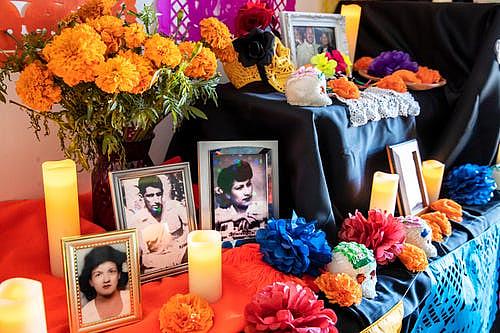Solo Inglés: How Coachella Valley senior centers overlooked Spanish speakers and how they can fix it.

Photographs of loved ones adorn a Day of the Dead ofrenda inside the Indio Senior Center in Indio, California, on November 2, 2021.
(Photo by Taya Gray/The Desert Sun)
After years of overlooking its Spanish speaking populations, some of Coachella Valley’s senior centers are finally reaching out, trying to bridge the gap and have their membership better reflect their city’s demographics. Leaders are adding Spanish programming, having a Lotería in addition to bingo, and, in at least one place, have hired an outreach coordinator.
But will this be enough?
Senior centers are meant to be resource hubs as well as community centers. It is where many older adults go first when looking for help with food, housing or other services. During the initial months of the COVID-19 pandemic, when Coachella Valley senior centers closed their doors, many residents were lost without the companionship they had afforded. And, even while closed, many of those same centers still provided services in the form of free meals, care packages and virtual classes.
Not everyone in the community benefited from what senior centers offered, however, including monolingual Spanish speakers, those without internet access or transportation. In some cases, residents fell into all three categories.
Lacking awareness of and equal access to the senior centers, these seniors were unable to take advantage of its valuable resources. Some of these services include the local food bank and Meals on Wheels as well as assistance with Medicare, Medicaid, low-income housing, food stamps, health care and legal aid.
Despite the area’s fame for events like Modernism Week and the Coachella Valley Music and Arts Festival (known as “Coachella”), about 15,000, or 15%, of Coachella Valley seniors lived in poverty prior to the pandemic, according to the 2018 Special Report on Senior Health in the Coachella Valley conducted by Health Assessment and Research for Communities (HARC) in Palm Desert. More than 7,300 seniors said they had to skip meals or cut the size of meals because they didn't have enough money for food, according to the report.
More than 20% of seniors had been diagnosed with one or more mental health disorders with depression being the most common. HARC found that over 3,600 seniors had seriously considered suicide in the previous year.
The pandemic just made these problems worse — and the inequities more glaring.
The senior centers know there are disparities and are working to address them. But, with limited funding and resources of their own, will their efforts lead to a significant impact?
As a 2022 California Fellow, I plan to survey Spanish speaking and minority seniors about what they want out of a senior center and what’s keeping them from utilizing them. What language are they most comfortable speaking in? What resources do they need? What programs would they like to attend? Where do they get their information from? (For example, radio, television, community bulletins, the newspaper, church, social media?) Are there other obstacles keeping them away?
My hope is that through this survey and reporting, and by learning how other centers have been able to reach this demographic, more awareness will be brought to this issue, enabling future outreach to be more effective.

